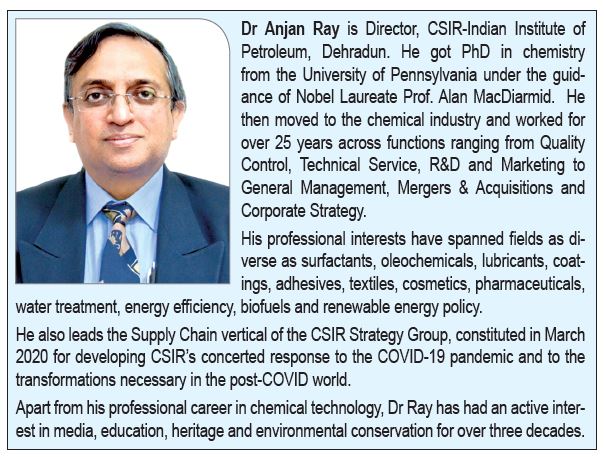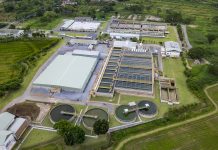Sustainability has become a powerful worldwide movement with government, industry and civil society realising that there is no other way, other than putting sustainability principles to work and into action to ensure that future generations are left with enough resources for their comfortable living on earth, that the ill effects of climate change are reversed before it reaches a point of no return and our entire living shifts to using materials that are totally benign to the environment, recyclable with no waste.
Sustainability is moving into wider and wider deployment in industry. What is the plan of action for its effective implementation and how can the results from transition to sustainable operations from each industry and every company be measured. Chemical Industry Digest in this special focus on sustainability in the chemical industry, discusses, debates and articulates the views of CEOs of global MNCs and major chemical companies, premier research organisation and global renewable carbon research and consultancy organisation. Chemical Industry Digest is privileged to obtain the views of Dr Anjan Ray is Director, CSIR-Indian Institute of Petroleum, Dehradun. His views are presented here.
Chemical Industry Digest (CID): Sustainability has become a loosely bandied word with many companies using the word sustainability as a promotional word attached to their company brand identity. How can we rid the concept of an arbitrariness and introduce a practical set of matrices to define it clearly? What are its more important components & characteristics, based on which best in class, measurable outcomes can be draw?
Dr Anjan Ray (AR): Validation of sustainability claims by companies is essential – but a complex exercise because the scope of the term is vast. There is at least one standard definition of sustainability that is currently well accepted around the world, that is the United Nations Sustainable Development Goals (SDGs). There are seventeen goals with 169 measurable parameters (target indicators) and those are all very good starting points. For ease of assessing industries through a sustainability lens, one might even simplify further and look at the concept of Gross Environmental Product being adopted by the State of Uttarakhand, where impact of industrial (or even services) activity on air, water, soil and forests are taken as primary indicators. These can be considered a practical set of metrics, easily understandable to all.
CID: To put sustainability principles into practice, how should an industry/manufacturing unit go about it? Should it revisit the entire length of its operations, from its supply chain to its manufacturing process to its end products to its packaging and delivery and convert them on sustainability parameters? What could be a practical roadmap with a plan of action?
AR: I think every company does indeed need to revisit its operations end-to-end. Not only its own operations but those of its vendors and the use and post-use behaviours of its customers in terms of the resource footprint, reusability and recyclability of its products. And producers should be tasked with evidence-based responsibility. So, for example, a cell phone manufacturer should look at all the metals that are in its components and whether those are mined or extracted sustainably by its vendors. And at how the end consumer disposes that cell phone and whether the disposal is sustainable. A company that enables effective recycling and reuse with zero or minimal impact to the environment while creating jobs should carry greater value that one that does not. The concepts of Circular Economy or its underlying principle of what we call Material Resource Efficiency might carry the most weight in such an assessment.

CSIR-Indian Institute of Petroleum is probably the only Institute in the country with a dedicated Material Resource Efficiency Division. We do consult for a range of agencies – including Corporates, government and intergovernmental multilateral organizations – who are interested in material resource efficiency assessments of their economic frameworks, products or supply chains.
The sustainability roadmap is unique to each organization’s line of business. Practically, a company may wish to look at the framework of the top tier of their products which bring in 80% of their revenues or volumes or profits. Ideally, I think an organization should be able to account for all or a substantial number of atoms of materials that go into its products along the entire value chain – and show what happens to these atoms (where they end up) at the end of the consumption cycle of its products. It would be also useful to measure its carbon footprint and water footprint along the cycle and the more this becomes institutionalized with frameworks already available, the more the chances that you can standardize issues like ESG funding and track everybody through the same sustainability lens.
CID: Business and industry are until now modelled on profitability outcomes which override other concerns. So how can corporates transit to the platform of sustainability? What would be the net benefits to companies for shifting to sustainability? Would it entail additional costs for its products and services?

AR: The next generation is going to receive an earth that is depleted of resources apropos overconsumption of this and past generations that did not take adequate care to live within the planet’s resource budgets. I think the mindset change that is needed is for every corporate leader to recognize that their children will be the most disadvantaged generation. The additional cost of products and services due to sustainable practices is a notional idea because of the way we account things on a gross domestic product basis or a gross national product basis but not on a gross environmental product basis.
The moment we start factoring sustainability into accounting and taking the amortized cost of environmental impact critically into our financial models, start assigning economic values to socio-cultural impact and economic impact on disadvantaged societies rather than just corporate shareholder value, we will start seeing very significant changes in the way companies behave. So it might incur additional cost in an optical sense using modern accounting methods but, in the long run, it makes sense just as once upon a time that happened around safety, health, occupational hygiene which moved beyond bare cost considerations.
I think most if not all corporations have realized over time and so have governments that safety, health and environment are all investments that pay back very, very significantly. They are not to be seen as costs but as investments with realistic returns. Decisions on safety, health and environment-related expediture have to be prioritized based on those returns not only to any single company and their constituent individuals but also to society and the planet.
CID: What factors are driving the adoption of sustainability by companies? Is it due to governmental pressures from global climate control treaties & societal pressures or is it intrinsically driven? What enabling factors can drive sustainability at an accelerated pace? Regulatory pressures? Governments incentivising the transition? Easier access to cost-competitive cleaner technologies? Access to cheaper funding for R&D and innovation? What else?
AR: This is a wide and complex question!
Almost everywhere in the world, regulatory regimes have been the first mover for sustainability. However, with the increasing globalisation of supply chains, sustainable practices have become equally important for trade participants in global markets, especially those who are suppliers to ESG-conscious companies. Incentives are invariably useful, but evidence suggests that early realisation of brand value in sustainable practices are a more powerful driver than fiscal incentives alone. Incentives tend to be relatively short-lived but are useful for “priming the pump” and building significant momentum around participation. Access to R&D funding and innovation has been useful in the India context, especially of late, with a host of funding opportunities and schemes coming out of government agencies like DST, DBT, CSIR, MOEFCC etc.
CID: Climate change and consequent global warming and its disastrous impact on the world are real and even frightening. What technological remedies are feasible in the short term and in the longer-term to address this? Shift to renewable fuels and feedstocks? Carbon dioxide capture, storage and utilisation? Or enhance process efficiencies or develop entirely new processes to ensure zero emission – zero waste? Or recycle waste back into the manufacturing process for a circular economy?
AR: I think the big pitfall here is that countries and regulators often tend to be technology arbiters. As a result, some things might get over-emphasised and some others that may be promising could be de-emphasized. The correct approach, in my view, should strive to be technologically neutral. Technologies should be incentivised based on their mitigation potential and affordability, and not only in terms of popular bandwagons.
 Recycling and circular economy principles, in general, carry a lot of value. As a country, India is short on land per capita and high on population per unit are at a broad average level compared to other nations. This suggests that high focus on anthropogenic waste – which scale with population and economic activity levels – is likely to pay greater dividends than land-intensive sustainability effort. It also suggests that more thought should go into multi-hybrid systems (such as wind-solar photovoltaics-biofuels or geothermal-solar thermal) and multi-sector efforts like agrivoltaics that can improve land utilisation.
Recycling and circular economy principles, in general, carry a lot of value. As a country, India is short on land per capita and high on population per unit are at a broad average level compared to other nations. This suggests that high focus on anthropogenic waste – which scale with population and economic activity levels – is likely to pay greater dividends than land-intensive sustainability effort. It also suggests that more thought should go into multi-hybrid systems (such as wind-solar photovoltaics-biofuels or geothermal-solar thermal) and multi-sector efforts like agrivoltaics that can improve land utilisation.
CID: To what extent can the adoption of Industry 4.0 digital technologies enable sustainability?
AR: This is a no-brainer. If we can measure it, we can improve it. Advanced digital technologies, data analytics, IOT and an orientation towards machine learning in the evolving complex systems is assured of multifold and quick payback. Whether it is in tracking waste atoms or renewable energy, digitalisation is the one sure way of ensuring we can compare apples with apples and have policy formation as well as deployment in an evidence-based manner.






























